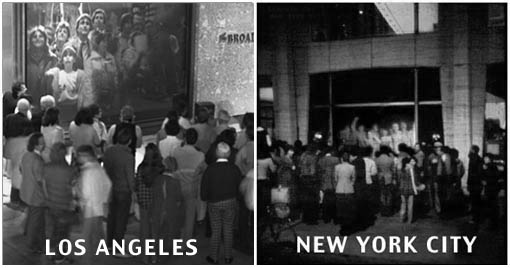Hole in Space, 1980 by Kit Galloway and Sherrie Rabinowitz
Collective Narrative
Artists’ intention:
We wanted to explore the aesthetics and sense of presence in a shared performance environment, where people don’t leave their indigenous environments. That way people from varied creative and cultural backgrounds could help create a new environment in which they could collaborate on an international scale.
In essence, Galloway’s and Rabinowitz’s body of work relates to the idea of people coming together in the ‘virtual space’ or the ‘third space’ (coined by Professor Randall). I find that they are similar to the Videofreex in the sense that they emphasise on collaboration. The Videofreex deeply involved the community of Lanesville in their pirate television, giving them the role of both the audience as well as the performer. Likewise for ‘Hole in Space’, collaboration is taken a step further when people from different locations interact with each other on life-sized screens, creating a hole in time and space.

Element of Surprise
I liked how deliberate the artists were in not providing titles, logos, instructions or explanations to the screens. They were essentially just screens and that added to the element of surprise and shock factor to the artwork. This was a wise decision as I felt like it made the artists’ intent that much clearer. Had there been any description or had the work been placed in a museum, I doubt the response of the people from LA and New York would be as emotionally compelling. People tend to regulate their behaviour when they are in a museum but in the street, it made sure that the audience were in their ‘indigenous environments’.
Emotional response
The emotional response to the work is a really good indicator of its success. Being able to map out the responses of the participants truly shows how experiential the hole in space is.
Since this work was done 37 years ago, the end of the video at 3.59 mins very useful as it provided extra context to the work. I found it surprising that the US(#16) was lagging behind countries like Korea and China in terms of broadband penetration and Singapore not far behind at #19. At that time there was a more pronounced digital divide, with people having less internet access than others.
Tiffany, I was very happy to see you make the connection between the Videofreex and Hole in Space. They were both about collaboration, and what I refer to as “social broadcasting.” However the hole in space created by the Videofreex was confined to the small area of Lanesville, NY. However, the reach of Hole in Space was 3,000 miles across the US. Now of course the reach of networked actions is global and do we ever take this for granted when you consider the past! And you are also right about the lack of labels, instructions, information: the viewers only had the information from the screen, which was a group people remotely greeting one another. And oh are you ever right about doing this piece as a public installation. It may have received a very difference response if exhibited within the walls of a museum. Kit and Sherrie were very conscious of the effect of placing the work in public and allowing the element of surprise as a major factor in the experience of the work.